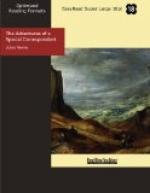We were talking about the safety of the Grand Transasiatic across Central Asia, and Pan Chao had said that the road was not so safe as it might be beyond the Turkestan frontier, as, in fact, Major Noltitz had told me. I was then led to ask if he had ever heard of the famous Ki Tsang before his departure from Europe.
“Often,” he said, “for Ki Tsang was then in the Yunnan provinces. I hope we shall not meet him on our road.”
My pronunciation of the name of the famous bandit was evidently incorrect, for I hardly understood Pan Chao when he repeated it with the accent of his native tongue.
But one thing I can say, and that is that when he uttered the name of Ki Tsang, Faruskiar knitted his brows and his eyes flashed. Then, with a look at his companion, he resumed his habitual indifference to all that was being said around him.
Assuredly I shall have some difficulty in making the acquaintance of this man. These Mongols are as close as a safe, and when you have not the word it is difficult to open them.
The train is running at high speed. In the ordinary service, when it stops at the eleven stations between Bokhara and Samarkand, it takes a whole day over the distance. This time it took but three hours to cover the two hundred kilometres which separate the two towns, and at two o’clock in the afternoon it entered the illustrious city of Tamerlane.
CHAPTER XII.
Samarkand is situated in the rich oasis watered by the Zarafchane in the valley of Sogd. A small pamphlet I bought at the railway station informs me that this great city is one of the four sites in which geographers “agree” to place the terrestrial paradise. I leave this discussion to the exegetists of the profession.
Burned by the armies of Cyrus in B.C. 329, Samarkand was in part destroyed by Genghis Khan, about 1219. When it had become the capital of Tamerlane, its position, which certainly could not be improved upon, did not prevent its being ravaged by the nomads of the eighteenth century. Such alternations of grandeur and ruin have been the fate of all the important towns of Central Asia.
We had five hours to stop at Samarkand during the day, and that promised something pleasant and several pages of copy. But there was no time to lose. As usual, the town is double; one half, built by the Russians, is quite modern, with its verdant parks, its avenues of birches, its palaces, its cottages; the other is the old town, still rich in magnificent remains of its splendor, and requiring many weeks to be conscientiously studied.
This time I shall not be alone. Major Noltitz is free; he will accompany me. We had already left the station when the Caternas presented themselves.
“Are you going for a run round the town, Monsieur Claudius?” asked the actor, with a comprehensive gesture to show the vast surroundings of Samarkand.




